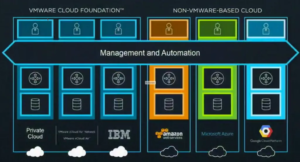
The cloud battle was fought with many contenders touting “Only Our Company can provide a true enterprise ready cloud service!”. Unfortunately, the foundation of the “enterprise ready” claim rested on the value prop that their cloud service was the best because it was built on industry leading/brand name hardware (EMC, Cisco, HP, Dell, etc…). However, In the end, the white boxes and self-developed control planes from AWS, Google, Microsoft, and IBM won.
A hyper competitive level of commodity services and prices was set, and vendors outside of the ‘Big 4’ were forced to either exit the market or strategically pivot and compete in the cloud market via cross-cloud orchestration services.
This shift was felt at VMworld 2016, with the primary theme of the first day’s keynote being around the subject of “Cross-Cloud” collaboration. VMware dove into the world of cross-cloud orchestration with the announcement of Cloud Foundation. Described as a marriage between public and private clouds, Cloud Foundation integrates vSphere, VSAN and NSX into a unified stack which can be provisioned either on premise or be run as a service in the cloud.
The over-arching idea is to simplify the provisioning and movement of workloads between customer’s on-premise vSphere environments and cloud infrastructure provided by the major public cloud providers. For example, if an application is overloading an on-premise vSphere instance the administrator can easily move that workload (along with the their carefully crafted NSX polices) to Azure for additional compute capacity, all with a few clicks of the mouse.
In conjunction with moving workloads from on-premise to the cloud (and vice-versa if desired), Cloud Foundation will also orchestrate between major public clouds. As part of the keynote demonstration an application hosted in the West region of the Amazon Public cloud was cloned to not only the East AWS region, but also quickly cloned to Azure for additional HA redundancy. With vSphere implemented in many data centers around the globe, Cloud Foundations is a natural extension to assist customers with in implementing their hybrid cloud strategies.
The fight to be one of the chosen few Enterprise Public Cloud Providers may be all but over, but with an estimated 53% of all workloads moving to the cloud by 2030, the battle for cross-cloud orchestration and integration supremacy will be continue.
Learn more about Zenoss Products and Solutions
Join and engage with the Zenoss Community








